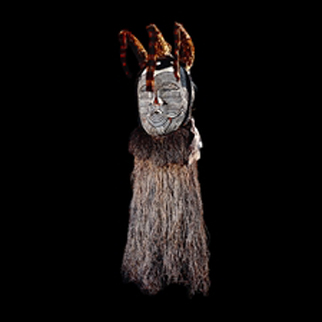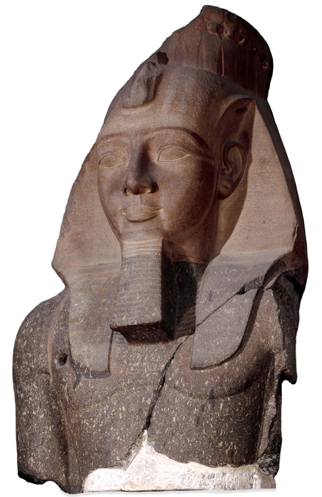2 A paradox and its consequences
Modern day thinking means we have to be very careful when discussing concepts such as ‘ancient Egyptian art’. On one side, as we have just seen, it is the very openness of our modern idea of art that permits us to regard as ‘art’ many things that were made for very different reasons. We regard an African mask as ‘art’ (Figure 3), but it is unlikely that a conventional middle-class Victorian would agree with us.

The nineteenth-century curators at the British Museum did not include Egyptian sculpture or the paintings from Nebamun’s tomb-chapel in their category of ‘fine art’, but we do.
The question of the artistic status of the sculptures and paintings of ancient Egypt much exercised connoisseurs in the early nineteenth century, and the reasons for their quandary say much about what the concept of ‘art’ has come to mean in modern Western societies, and what key values the notion of a ‘Western canon’ embraces.
In 1819 a leading Trustee of the British Museum Sir Joseph Banks wrote to Henry Salt, who had offered for sale his collection of Egyptian antiquities:
Though in truth we are here much satisfied with the Memnon [i.e. the colossal bust of Ramses II (Figure 4)], and consider it as a chef d’oeuvre of Egyptian sculpture; yet we have not placed that statue among the works of Fine Art. It stands in the Egyptian rooms. Whether any statue that has been found in Egypt can be brought into competition with the grand works of the Townley Gallery remains to be proved.
The Townley Gallery housed a collection of ancient Roman sculptures assembled by Sir Charles Townley.

In similar vein, the New Monthly Magazine wrote in 1821 that:
Eastern style [including Egyptian] ... contrary to the Western, depended upon bulk rather than beauty; upon strength and uniformity, and upon massiveness of light and shade, rather than upon elegance of individual parts and the graceful proportions of a whole, for its magnificence. (p. 617)
Likewise, the Annals of the Fine Arts claimed:
They bear the character of the infancy of art, rude in their design, yet imposing in their massiveness and extraordinary size; they attest more to the vast power and perseverance of the bodily powers, than great exertions of a cultivated mind.
The same position was maintained by Peter Patmore in his Guide to the Beauties of the British Museum published in 1826. For him, the arts of Egypt ‘exercise an almost painful and oppressive effect on the imagination’ by the emphasis they suggest on ‘physical power’. They exhibit a ‘want of character’, they are ‘without any individual expression’.
It is not the craftsmanship that is disparaged, quite the reverse. For Patmore writing about the bust of Rameses II states ‘nothing can be more beautifully executed, in point of mere workmanship, than this noble fragment’. What is lacking in Egyptian art is something more profound according to Patmore who writes ‘There is no life in it – no character – no expression … there is nothing individualised about it’. He clinches his assertion by claiming ‘It is not a piece of sculpture, but a piece of stone’.
Look again at the quotations above. What would you pick out as the key terms in this doubt about the ability of ancient Egyptian work to be regarded as ‘art’, and what is it contrasted with?
One important point is that ‘art’ is seen as involving something over and above ‘craftsmanship’. The manual skill involved in making the Egyptian pieces is acknowledged. But what it is seen as lacking is a range of qualities to do with individuality – life, character, expression.
Rather than the mind, Egyptian art is regarded as speaking to the body. It is ‘rude’, dating only from the ‘infancy’ of art. It suggests physical power rather than a cultivated mind, and by extension, the ‘cultivated mind’ can feel no human sympathy for it. All of these qualities are associated with ‘the East’. And by contrast, all those values that are celebrated, such as individuality of expression and mind, are identified with the classical civilisations of Greece and Rome, the roots of the ‘Western’ tradition.
This is a very different situation from the one in which we find ourselves. In the early nineteenth century, the dual Christian/Classical tradition, rooted in Greece, defined the western canon of art and either completely excluded or at best marginalised everything else. Whereas for us, the concept of art has become, so to speak, omnivorous. We can apply it to miscellaneous collections of objects, videos, fleeting actions and disparate installations as well as paintings and sculptures, and these things can be from anywhere around the globe.
Furthermore, we have no difficulty in applying it retrospectively to a range of objects, that when they were made were not conceived under the rubric ‘art’ as we now employ it, and to a range of skills and activities the exercise of which constituted nothing like an independent practice of art on our model.
